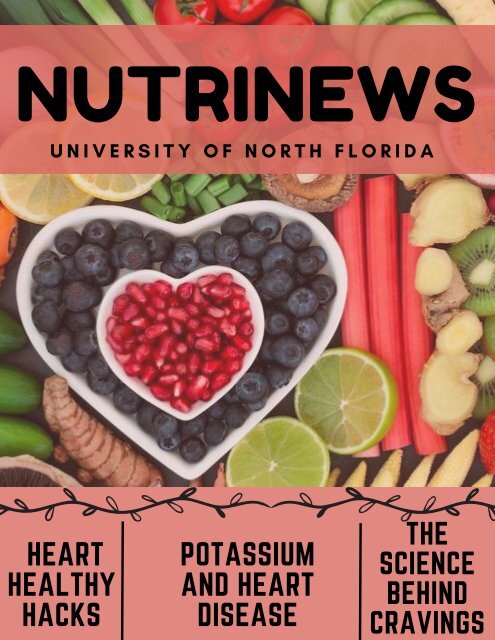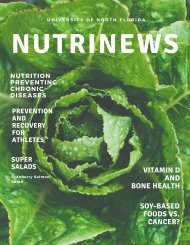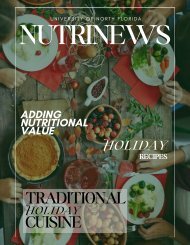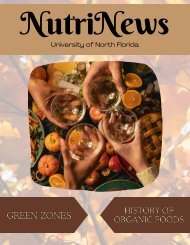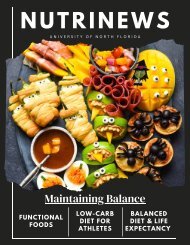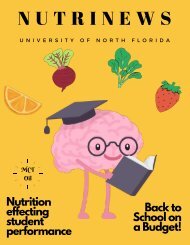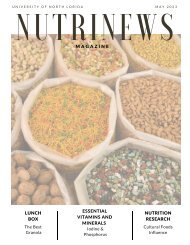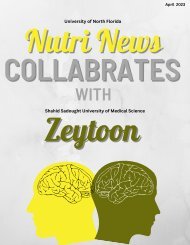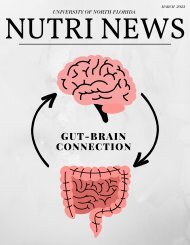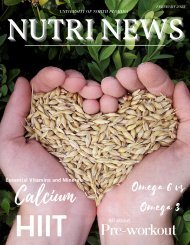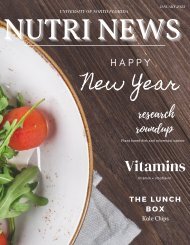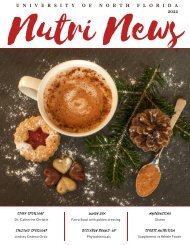February Issue 2024
This month the theme of our issue is Young at Heart. February is here and that means heart health month is too! In this issue of NutriNews we focus on nutrition and heart health. Lifestyle and nutrition play a significant role in our health, especially when it comes to the heart.
This month the theme of our issue is Young at Heart. February is here and that means heart health month is too! In this issue of NutriNews we focus on nutrition and heart health. Lifestyle and nutrition play a significant role in our health, especially when it comes to the heart.
You also want an ePaper? Increase the reach of your titles
YUMPU automatically turns print PDFs into web optimized ePapers that Google loves.
NUTRINEWS<br />
U N I V E R S I T Y O F N O R T H F L O R I D A<br />
HEART<br />
HEALTHY<br />
HACKS<br />
POTASSIUM<br />
AND HEART<br />
DISEASE<br />
THE<br />
SCIENCE<br />
BEHIND<br />
CRAVINGS
Table of Contents<br />
“ L O V E Y O U R S E L F F I R S T , A N D E V E R Y T H I N G E L S E F A L L S I N<br />
L I N E . Y O U R E A L L Y H A V E T O L O V E Y O U R S E L F T O G E T<br />
A N Y T H I N G D O N E I N T H I S W O R L D . ”<br />
- L U C I L L E B A L L<br />
MYTH BUSTING<br />
What Causes Cravings?<br />
06<br />
LUNCH BOX<br />
Walnut Rosemary Crusted Salmon 08<br />
COMMUNITY/CLUB SPOTLIGHT<br />
Get to Know Our UNF Rugby Club<br />
09<br />
MONTHLY HACKS<br />
5 Monthly Hacks to a Healthy Heart 10<br />
SATFF SPOTLIGHT<br />
Staff Interview with Jill Snyder<br />
12<br />
NUTRITION RESEARCH<br />
High Cholesterol Levels Leading to Heart Disease 17<br />
STUDENT SPOTLIGHT<br />
Student Interview with Katie Aljian<br />
18<br />
VITAMINS AND MINERALS<br />
Potassium Impacting Cardiovascular Health 20<br />
SPORTS NUTRITION<br />
Analyzing Different Types of Fats<br />
24<br />
NUTRINEWS STAFF<br />
Get to Know Our Staff!! 28
International Day of<br />
Women & Girls in Science<br />
11 <strong>February</strong> <strong>2024</strong>
During this study, participants may be asked to:<br />
•Complete questionnaires online<br />
•Provide samples of stools (The expenses will be covered)<br />
•Participants will receive a total of $200 in gift cards during the study<br />
FOR MORE INFORMATION:<br />
email: alireza.jahan-mihan@unf.edu<br />
email: j.leftwich@unf.edu<br />
email: n00128399@unf.edu<br />
Call:904-620-5359<br />
Call: 904-415-4288<br />
Call: 904-413-3031
MYTH BUSTING<br />
CRAVINGS: MEANING,<br />
CAUSE AND EFFECTS?<br />
Written by: Katherine Aljian<br />
We are surrounded by false and<br />
misleading information. There<br />
are tall tales around the subject<br />
of cravings and the meaning,<br />
cause, and effect they could<br />
have on our bodies. Cravings<br />
don’t come from the stomach;<br />
they have a lot to do with the<br />
hormones in your body. The<br />
following hormones are<br />
instrumental in why you get<br />
cravings: leptin, ghrelin,<br />
dopamine, and insulin. These<br />
are included in the function of<br />
digestion, with ghrelin causing<br />
hunger, leptin decreasing<br />
appetite, and dopamine causing<br />
the reward system when you eat.<br />
When you have a hankering for<br />
cookies, it doesn’t mean your body<br />
needs glucose. Rather, it could<br />
mean that you have easy access to<br />
foods, which makes cravings<br />
stronger. In some cases, you could<br />
be craving the feeling of your<br />
reward system (dopamine) when<br />
you consume these hyperpalatable<br />
foods (easily digestible<br />
foods usually described as sweet,<br />
salty, or rich).1 A study done on<br />
rats by Sara F. Leibowits found<br />
that neuropeptide Y causes<br />
carbohydrate cravings and that<br />
galanin causes the yearning for<br />
fat.2 While the data usually<br />
indicates galanin causes fat<br />
cravings, some researchers<br />
dispute this argument.<br />
Other factors in life that can<br />
influence cravings include food<br />
advertisements, stress,<br />
inadequate sleep, exercise,<br />
hormonal changes, medication,<br />
and many others. Fast food<br />
industries will usually cherrypick<br />
health facts about their<br />
foods, creating the illusion that<br />
you are purchasing nutritious<br />
products.3 There are two types<br />
of stress: chronic and acute.<br />
Acute stress can cause a loss of<br />
appetite, while chronic stress<br />
can alter your cortisol levels,<br />
causing you to crave unhealthy<br />
foods.1 Inadequate sleep is<br />
associated with imbalances in<br />
leptin and ghrelin levels. When<br />
you exercise, your body is<br />
under stress, causing blood to<br />
leave the gut and go to your<br />
muscles and heart. This causes<br />
you to be less hungry when<br />
you're working out, but when<br />
you’re finished, normal hunger<br />
cues will return.1 Hormone<br />
changes, such as the menstrual<br />
cycle, can cause an increase or<br />
decrease in cravings. Different<br />
types of medications can cause<br />
a decrease in appetite or an<br />
increase as well. If you are<br />
worried about your appetite<br />
regarding medication, you<br />
should talk to a medical<br />
professional.<br />
6
Your body is a very intricate system that is complex and requires proper<br />
nutrition. These systems can easily be thrown out of balance, so it's your<br />
responsibility to keep your body in a state of homeostasis. There are many<br />
reasons why we get cravings, but next time you crave a dessert, ask yourself<br />
if you are hungry; if so, maybe try to have an orange or a mango. Food is<br />
fuel for your body, and the more quality food you put in, the more<br />
efficiently your brain and body will work. It is important to treat your body<br />
with respect and make sure you’re on a healthy path in life.<br />
11.Cravings. Harvard T.H. CHAN, 2023, DOI:12.23.2023. Cravings | The Nutrition Source |<br />
Harvard T.H. Chan School of Public Health<br />
2.Pennisi, E. Food Cravings Tied to Brain Chemicals. Society for science & the public.<br />
1993; Vol. 144, No.20, p. 144. : https://www.jstor.org/stable/3977801<br />
3.How can advertisements influence your food choices? CNS. 2020. Accessed December<br />
27, 2023. https://cns.ucdavis.edu/news/how-can-advertisements-influence-your-foodchoices<br />
4.Kenny, P.J. The Food Addiction. Scientific American. 2013; vol. 309, No. 3. Pp. 44-49.<br />
https://www.jstor.org/stable/10.2307/26017984<br />
5.How Food can Impact Your Heart. Northwestern Medicine. How Overeating Can Impact<br />
Your Heart | Northwestern Medicine<br />
6.Ajmera, R. 17 Incredible Heart-Healthy Foods. Healthline. November 17, 2023. 17<br />
Incredibly Heart-Healthy Foods (healthline.com)<br />
7.Eske, J. Dopamine and serotonin: Brain chemicals explained. MNT. October 2023.<br />
Dopamine vs. serotonin: Similarities, differences, and relationship<br />
(medicalnewstoday.com)<br />
7
The Lunch Box<br />
Walnut Rosemary Crusted<br />
Salmon<br />
By: Jace Brown<br />
When looking for a heart-healthy recipe, traditional<br />
American food likely isn’t what first comes to mind.<br />
Instead, this month’s dish better aligns with the<br />
dietary habits found in the birthplace of western<br />
civilization and the modern blue zone of Icaria,<br />
Greece. Walnut rosemary-crusted salmon is an<br />
entrée that aligns with the Mediterranean diet and<br />
overflows with omega-3 fatty acids. According to the<br />
American Heart Association, walnuts are a rich<br />
source of omega-3s, and the National Institute of<br />
Health reports that salmon has a high amount of<br />
omega-3s as well. Rosemary is also documented to<br />
have anti-inflammatory properties by the National<br />
Institutes of Health. Unsaturated fats are a staple of<br />
the Mediterranean diet, and according to the blue<br />
zone, they might be an essential ingredient for<br />
longevity.<br />
Start preparing this meal by preheating your oven to 400<br />
degrees. Next, mix 1 ½ tsp of lemon juice, 1 ½ tsp of<br />
rosemary leaves, 1 tbsp of sweet and sour sauce, 1 tsp of<br />
garlic powder, and 1 tbsp of olive oil in a bowl. Then chop<br />
2 tablespoons of walnuts into crumbs and place them in<br />
another bowl. Dip the salmon fillets into the sweet and<br />
sour mixture, then the walnut crumbs. Place on a baking<br />
sheet with parchment paper and bake until the salmon is<br />
145 degrees or can flake easily with a fork.<br />
8
UNF RUGBY<br />
INTERESTED IN RUGBY FOOTBALL?<br />
CONSIDER JOINING THE DEADBIRDS.<br />
ABOUT<br />
DIVISION 1<br />
MEN’S RUGBY TEAM<br />
TO TRY OUT:<br />
PLAYS IN THE FLORIDA<br />
CONTACT CLUB<br />
COLLEGIATE CONFERENCE<br />
PRESIDENT<br />
CHRISTOPHER FRIEND<br />
PRACTICE TIMES<br />
(850) 933-4281<br />
TUES/THUR 8:00PM-10:00PM<br />
PARKING LOT 17 FIELD<br />
TO FOLLOW ONLINE:<br />
INSTAGRAM<br />
SEASONS<br />
@UNFRUGBYCLUB<br />
FALL: PRE-SEASON<br />
FACEBOOK<br />
PRACTICE AND FREE PLAY<br />
UNF DEADBIRD RFC<br />
SPRING: COMPETITION<br />
YOUTUBE<br />
TRACK SCORES ACROSS THE<br />
DEADBIRDRUGBY134<br />
SEMESTER... SEE BELOW!<br />
(PHOTOGRAPHS COURTESY OF UNF RUGBY FOOTBALL<br />
PRESIDENT CHRISTOPHER FRIEND FOR UNF NUTRINEWS)<br />
9
HACKS TO KEEP<br />
YOUR HEART<br />
5HEALTHY<br />
BY SOPHIA HARRIS<br />
Did you know that heart disease is a leading cause of death for people across<br />
different races and ethnicities? Every thirty-three seconds a person dies of<br />
cardiovascular disease. To reduce the number of people who develop cardiovascular<br />
disease, it is important to take care of your heart.1 There are many ways to take care<br />
of your heart, such as by altering what you eat and increasing your daily activity.<br />
One way to reduce your chances of developing heart<br />
disease is to pay attention to what you eat. Of course, you<br />
want to focus on foods like fruits, vegetables, beans,<br />
legumes, whole grains, fat-free/low-fat dairy, and healthy<br />
fats (avocados and olive oil).2 Use herbs and spices in<br />
higher amounts or in place of salt as well.2 These foods<br />
help protect the heart from high blood pressure, bad<br />
cholesterol, and type two diabetes.3 There are also some<br />
dietary factors that can contribute to the development of<br />
heart disease. For example, eating a lot of high-sodium<br />
dishes, added sugars, refined carbohydrates, alcohol,<br />
saturated fats, and trans fats may increase your risk for<br />
cardiovascular disease. Two diet plans that can help you<br />
consume less sodium, added sugars, and unhealthy fats<br />
are the Mediterranean diet and the Dietary Approaches to<br />
Stop Hypertension.3<br />
Another way to reduce your risk of cardiovascular disease is to move your body<br />
for at least thirty to sixty minutes a day. Getting enough exercise can help protect<br />
you from high blood pressure, high cholesterol, and type two diabetes, all of which<br />
can put a lot of stress on the heart.1,3 Different forms of exercise include running,<br />
walking, gardening, doing housework, and even going up and down stairs.3 Getting<br />
enough sleep can also stop people from getting high blood pressure, heart attacks,<br />
diabetes, and depression. To help make sure that you get enough sleep, keep your<br />
room dark and quiet and maintain a regular sleep schedule.3<br />
10
Stay away from cigarettes and other<br />
tobacco products. The chemicals in<br />
tobacco not only damage the blood<br />
vessels, but they negatively impact the<br />
heart, brain, and other parts of the body<br />
as well. Smoking can also increase your<br />
likelihood of developing high blood<br />
pressure and make the heart beat harder<br />
than normal, as smoke lowers the levels<br />
of oxygen in the lungs.2,3<br />
Chronic stress can not only take a toll on your mental health, but it can also jeopardize<br />
your physical health. Stress may increase blood pressure, reduce blood flow to the heart, and<br />
worsen anxiety and depression. Mayo Clinic recommends finding healthy ways to cope with<br />
stress, such as yoga, meditation, physical activity, relaxation exercises, and mindfulness.3<br />
Mindfulness and meditation are two different things. Mindfulness is being aware of yourself<br />
and what you are doing without becoming overwhelmed.4 Meditation refers to being in a<br />
state of deep rest whilst being aware and conscious at the same time.4 When choosing any<br />
physical activity, make sure to choose one that you know will make you happy. Examples of<br />
physical activity include walking, stair climbing, jogging, dancing, bicycling, yoga, tai chi,<br />
gardening, weightlifting, and swimming.5 Remember that you don’t have to adopt all of these<br />
habits right away. I plan on picking the one that I am currently struggling with the most and<br />
trying to only focus on that one habit until I feel like I have a good grasp on it. Hopefully one<br />
or all these tips can help you achieve the goal of improving your heart health.<br />
1.Heart disease facts. Centers for Disease Control and Prevention. Updated May 15, 2023. Accessed December 28, 2023. https://www.cdc.gov/heartdisease/facts.htm.<br />
2.Keeping your heart healthy. Heart Foundation. Accessed December 28, 2023. https://www.heartfoundation.org.au/bundles/healthy-living-and-eating/keeping-your-heart-healthy.<br />
3. Strategies to prevent heart disease. Mayo Clinic. Published August 17, 2023. Accessed December 28, 2023. https://www.mayoclinic.org/diseases-conditions/heart-disease/in-depth/heart-disease-prevention/art-20046502.<br />
4. Shah S. Mindfulness vs meditation: Know both well and pick the best for you. The Art Of Living. Published September 20, 2023. Accessed December 28, 2023. https://www.artofliving.org/us-en/blog/mindfulness-vs-meditationknow-both-well-and-pick-the-best-for-you.<br />
5. Stress management. Mayo Clinic. Published August 3, 2022. Accessed December 28, 2023. https://www.mayoclinic.org/healthy-lifestyle/stress-management/in-depth/exercise-and-stress/art-<br />
20044469#:~:text=Almost%20any%20form%20of%20exercise,%2C%20gardening%2C%20weightlifting%20and%20swimming.<br />
11
UNF NUTRINEWS<br />
FEBRUARY <strong>2024</strong><br />
COMING TO<br />
THE NEST...<br />
Y E A R S I N T H E F I E L D ?<br />
2 0 Y E A R S<br />
Y E A R S W I T H U N F ?<br />
S I N C E R E C E I V I N G H E R<br />
B A C H E L O R ’ S , M A S T E R ’ S , A N D<br />
D O C T O R A T E D E G R E E S H E R E A T<br />
U N F , S H E H A S B E E N T E A C H I N G<br />
F O R T H E P A S T D E C A D E .<br />
B O N U S :<br />
D R . S N Y D E R I S A F L O R I D A<br />
N A T I V E — B O R N A N D R A I S E D<br />
I N J A X B E A C H !<br />
W H A T D O Y O U<br />
C U R R E N T L Y D O W I T H U N F ?<br />
12<br />
C L I N I C A L P R A C T I C E A R E A S :<br />
E A T I N G D I S O R D E R S<br />
A N D S P O R T S N U T R I T I O N<br />
P R O G R A M D I R E C T O R<br />
F O R M S / D I A N D I S S P<br />
P E R F O R M A N C E D I R E C T O R<br />
F O R U N F A T H L E T I C S
LEARNING TO FLY<br />
W H A T M O T I V A T E D<br />
Y O U T O C H O O S E<br />
N U T R I T I O N ?<br />
Her mother’s cancer<br />
diagnosis pushed her toward<br />
health studies, while her<br />
father’s football coach work<br />
influenced her focus: sports<br />
nutrition.<br />
D I D Y O U A L W A Y S<br />
W A N T T O B E A<br />
P R O F E S S O R ?<br />
Dr. Snyder has “always loved<br />
teaching,” and has had to<br />
teach, even in past parts of<br />
her career.<br />
“Working with eating<br />
disorders is very emotional,”<br />
she shares, as she describes<br />
life before professorship: 12-<br />
hour shifts of consulting<br />
with an in-patient treatment<br />
center.<br />
This in combination with her<br />
experience as a fitness<br />
instructor, becoming a part<br />
of UNF staff was a natural<br />
fit.<br />
W H A T A R E T H E<br />
B I G G E S T C H A L L E N G E S<br />
O F Y O U R F I E L D ?<br />
“Combating all of the<br />
misinformation around<br />
nutrition from other health<br />
professionals.”<br />
I N S P I R A T I O N F O R<br />
F U T U R E O S P R E Y S :<br />
Pursuing Nutrition &<br />
Dietetics?<br />
“Follow your dreams,” she<br />
declares, having been<br />
told she could not do<br />
sports, now a<br />
professional dietitian in<br />
UNF Athletics.<br />
F I N A L F U N F A C T S :<br />
Dr. Snyder is a former...<br />
triathlete<br />
marathon runner<br />
and personal trainer!<br />
While she’s not teaching,<br />
she loves visiting the<br />
beach, sailing in the<br />
Caribbean, and going<br />
dog sledding!<br />
13
https://www.worldcancerday.org/<br />
Despite the continuous efforts and improvements in cancer<br />
research and technology, people still have multiple barriers that<br />
prevent them from accessing proper treatment and care.<br />
These barriers to treatment and care include: “Income, education,<br />
geographical location and discrimination based on ethnicity,<br />
gender, sexual orientation, age, disability and lifestyle”<br />
With this years theme, World Cancer Day encourages our leaders<br />
to address these health disparities and address their root causes<br />
to ensure equal access to life-saving treatments for everyone.<br />
Statistics:<br />
World Cancer Day<br />
4 <strong>February</strong> <strong>2024</strong><br />
This year’s theme: Close the Care Gap<br />
In the US, the 5 year survival rate of cervical cancer for white<br />
women is 71 % and for black women it is 58%.<br />
Childhood cancer survival rates in high-income countries is about<br />
80% but is about 20% in low-income countries.<br />
Cancer is the cause of death for nearly 10 million people each<br />
year about 70% of which are ages 65 or older.<br />
Due to discrimination from healthcare providers, transgender<br />
people are less likely to undergo cancer screening than cisgender<br />
people.<br />
There is a significant difference in access to care in rural and<br />
urban areas resulting in higher rates of mortality due to cancer in<br />
rural areas. These differences are related to the lack of access to<br />
providers, longer travel times, and the financial burden of the<br />
expensive healthcare costs.
Lets Celebrate<br />
Black<br />
History<br />
Month<br />
<strong>February</strong> 1st -<br />
March 1st
Nutrition Research<br />
IS HIGH CHOLESTEROL CORRELATED<br />
TO HEART DISEASE?<br />
Written By: Tavianna Brooks<br />
Almost 25 million American adults have high total serum cholesterol levels above 240 mg/dL, whereas 86 million are<br />
above 200 mg/dL.1 Seven percent of U.S. children and adolescents aged 6-19 have high cholesterol.1 High cholesterol is a<br />
serious issue because it has no symptoms and increases the risk of heart disease, which is the leading cause of death in<br />
America.1 However, cholesterol is not inherently bad; it is the component of cell membranes, maintaining structural<br />
integrity and regulating fluidity.2 Also, cholesterol is a precursor for steroids such as vitamin D3-4 and adrenocortical<br />
hormones.5-6 Among other functions, cholesterol is vital to our overall health. So how could high total serum cholesterol<br />
indicate and lead to heart disease?<br />
Cholesterol has two origins: endogenous and exogenous. Our liver actively produces the cholesterol we need,<br />
whereas we also get it from dietary sources like animal products.7 Since cholesterol is insoluble in water, it will be<br />
transported through lipoprotein, a lipid-protein compound.8 Lipoproteins are vital in lipid and cholesterol metabolism and<br />
travel throughout the body.8-9 There are various lipoproteins categorized based on their density: chylomicrons, very-lowdensity<br />
lipoproteins (VLDL), low-density lipoproteins (LDL), and high-density lipoproteins (HDL). Chylomicrons are<br />
synthesized in the small intestine where VLDL, LDL, and HDL are synthesized in the liver and small intestine.9 Chylomicrons<br />
would travel to the liver to be turned into VLDL.9 Then, VLDL would exit the liver to transport triacylglycerol to extrahepatic<br />
tissues.9 LDL, infamous as the “bad” cholesterol, transports cholesterol to tissues.8-9 LDL could build up plaque in the<br />
arteries, causing blockages leading to heart disease and stroke.1 HDL, famed as the “good” cholesterol, removes<br />
cholesterol from the tissue, delivering it to the liver for bile formation or excretion.8-9 HDL has been linked to lowering the<br />
risk of heart disease and stroke.1 However, recent studies have shown dietary cholesterol is not significantly impactful on<br />
serum cholesterol levels as once believed.10,11 The culprit would be saturated and trans fats.7,10,11<br />
Lifestyle habits, such as diet and physical inactivity1, and genetic influence, increases our chances of<br />
having high cholesterol.10 Many foods that are high in cholesterol, are also high in saturated fat, but an<br />
exception is shrimp.11 Choosing lean and nutrient dense proteins such as egg is a great option for low<br />
cholesterol.11 Soluble fiber will bind to cholesterol and exit the body through the gastrointestinal tract, and<br />
foods rich in soluble fiber are whole grains, beans, and fruits and vegetables.7 Polyunsaturated fat lowers<br />
LDL cholesterol, and foods rich in this are nuts and vegetable oils.7<br />
It is important to remember to get checked for high cholesterol via blood test, especially if there is a family<br />
history of “heart disease, diabetes, or a family history of high cholesterol”.1<br />
Works Cited<br />
1.<br />
Centers for Disease Control and Prevention. High Cholesterol Facts | cdc.gov. U.S Department of Health & Human Services. Published May 15, 2023. https://www.cdc.gov/cholesterol/facts.htm#:~:text=Nearly%2025%20million%20adults%20in<br />
2.<br />
Jaipuria G, Ukmar-Godec T, Zweckstetter M. Challenges and approaches to understand cholesterol-binding impact on membrane protein function: an NMR view. Cellular and molecular life sciences: CMLS. 2018;75(12):2137-2151. doi:https://doi.org/10.1007/s00018-018-2789-9<br />
3.<br />
Rone MB, Fan J, Papadopoulos V. Cholesterol transport in steroid biosynthesis: Role of protein–protein interactions and implications in disease states. Biochimica et Biophysica Acta (BBA) - Molecular and Cell Biology of Lipids. 2009;1791(7):646-658.<br />
doi:https://doi.org/10.1016/j.bbalip.2009.03.001<br />
4.<br />
Harvard Health Publishing. How it’s made: Cholesterol production in your body - Harvard Health. Harvard Health. Published July 31, 2019. https://www.health.harvard.edu/heart-health/how-its-made-cholesterol-production-in-your-body<br />
5.<br />
Zhang J. Cholesterol content in cell membrane maintains surface levels of ErbB2 and confers a therapeutic vulnerability in ErbB2-positive breast cancer. Cell Communication and Signaling. 2019;17(1). doi:https://doi.org/10.1186/s12964-019-0328-4<br />
6.<br />
Qamar A, Bhatt DL. Effect of Low Cholesterol on Steroid Hormones and Vitamin E Levels. Circulation Research. 2015;117(8):662-664. doi:https://doi.org/10.1161/circresaha.115.307345<br />
7.<br />
American Heart Association. What Is Cholesterol? www.heart.org. Published November 6, 2020. https://www.heart.org/en/health-topics/cholesterol/about-cholesterol<br />
8.<br />
University of Texas Medical Branch. Cholesterol Metabolism. Utmb.edu. Published 2009. https://www.utmb.edu/pedi_ed/Obesity/page_19.htm<br />
9.<br />
Cherian G. VIII. Lipids, Transport, Deposition, and Metabolism. openoregonstateeducation. Published online April 14, 2019. https://open.oregonstate.education/animalnutrition/chapter/chapter-<br />
8/#:~:text=Blood%20lipids%20are%20transported%20as,and%20outer%20proteins%20(apolipoprotein).<br />
10.<br />
Fernandez ML, Murillo AG. Is There a Correlation between Dietary and Blood Cholesterol? Evidence from Epidemiological Data and Clinical Interventions. Nutrients. 2022;14(10):2168. doi:https://doi.org/10.3390/nu14102168<br />
11.<br />
Soliman G. Dietary Cholesterol and the Lack of Evidence in Cardiovascular Disease. Nutrients. 2018;10(6):780. doi:https://doi.org/10.3390/nu10060780<br />
17
N U T R I N E W S<br />
T E A M<br />
S P O T L I G H T :<br />
K A T I E A L J I A N<br />
W H A T I S Y O U R D E G R E E A N D<br />
W H A T I N S P I R E D Y O U T O<br />
P U R S U E I T ?<br />
My degree is in Nutrition and dietetics. I<br />
decided to pursue this profession<br />
because I have always loved the health<br />
field and wanted to help people. I also<br />
have had a passion for food and the<br />
delectable tastes we can create so I<br />
thought this would be the perfect path.<br />
W H A T H A S B E E N Y O U R<br />
F A V O R I T E P A R T O F Y O U R<br />
P R O G R A M ?<br />
Being able to learn more every day about<br />
food and our bodies and the way it all<br />
correlates to what we put into our bodies,<br />
that’s my favorite part.<br />
W H A T H A S B E E N T H E<br />
M O S T C H A L L E N G I N G<br />
P A R T O F Y O U R<br />
P R O G R A M ?<br />
What is your<br />
favorite color?<br />
Emerald green<br />
What is your<br />
favorite food?<br />
Sushi<br />
What is your<br />
favorite book?<br />
Twisted Love by<br />
Ana Huang<br />
The most challenging part of the<br />
program was the labs I had to take with<br />
my classes. The lab portion of the courses<br />
require just as much work as lecture. So, it<br />
is important to also prioritize those.<br />
18
A L L A B O U T<br />
K A T I E A L J I A N<br />
W H A T H A S B E E N T H E<br />
M O S T C H A L L E N G I N G<br />
P A R T O F Y O U R<br />
P R O G R A M ?<br />
W H A T C L U B S A R E Y O U<br />
I N V O L V E D I N A T U N F ?<br />
W H A T A C T I V I T I E S D O<br />
Y O U E N J O Y D O I N G<br />
O U T S I D E O F Y O U R<br />
A C A D E M I C S ?<br />
W H A T A D V I C E D O Y O U<br />
H A V E F O R O T H E R<br />
S T U D E N T S ?<br />
The most challenging part of the<br />
program was the labs I had to take with<br />
my classes. The lab portion of the courses<br />
require just as much work as lecture. So, it<br />
is important to also prioritize those.<br />
Currently I am only involved in NutriNews.<br />
However, I am trying to get involved in<br />
more UNF clubs.<br />
I play flag football for the UNF<br />
intramurals, and I have dabbled in<br />
intramural basketball. I love art and<br />
painting in my free time along with<br />
reading<br />
Staying on top of your work and studying<br />
is the best thing you can do for your<br />
academics. Health wise I would say just<br />
make sure you are eating and drinking<br />
enough water because when you are<br />
busy it is easy to forget.<br />
19
Vitamins and Minerals<br />
T H E R O L E O F P O T A S S I U M I N<br />
C A R D I O V A S C U L A R H E A L T H<br />
By: Madison Cashman<br />
Cardiovascular diseases continue to pose a significant global<br />
health challenge. This calls for a need of a deeper<br />
understanding of factors influencing heart health. One factor<br />
gaining prominence is potassium, a mineral that plays a crucial<br />
role in maintaining cardiovascular well-being.<br />
20
H O W T O O L I T T L E<br />
P O T A S S I U M M A Y<br />
C O N T R I B U T E T O<br />
C A R D I O V A S C U L A R<br />
D I S E A S E<br />
Studies have found a significant link<br />
between low potassium levels and<br />
vascular calcification, a process<br />
associated with atherosclerosis.<br />
Insights from mouse studies reveal<br />
the impact of potassium on arterial<br />
stiffness and calcification, shedding<br />
light on potential preventive and<br />
treatment strategies. 1<br />
U N D E R S T A N D I N G T H E<br />
M E C H A N I S M<br />
Building upon the research, it is<br />
important to explore the<br />
mechanisms through which<br />
potassium influences vascular<br />
calcification. By examining changes<br />
in protein expression within<br />
vascular smooth muscle cells, the<br />
study identifies the activation of<br />
specific proteins and increased<br />
autophagy as critical components<br />
in the calcification process when<br />
potassium levels are low. 1<br />
H O W P O T A S S I U M H E L P S Y O U R H E A R T<br />
Beyond its role in triggering the heart to<br />
pump blood through the body, potassium<br />
extends its influence ranging from muscle<br />
functionality and nerve conduction to kidney<br />
filtration. 2 These multifaceted contributions<br />
make potassium an essential element for<br />
maintaining the balance required for optimal<br />
cardiovascular function.<br />
T H E B E N E F I T S O F P O T A S S I U M<br />
Expanding on potassium's benefits, a diet rich in<br />
potassium can positively impact blood pressure<br />
regulation. It also touches upon the indirect link<br />
between potassium and cholesterol, explaining how<br />
potassium-rich diets align with heart-healthy<br />
dietary patterns. 2 The role of potassium in<br />
maintaining a regulated heartbeat is extremely<br />
important, especially for individuals with rhythm<br />
problems.<br />
21
F O O D S R I C H I N P O T A S S I U M<br />
Understanding the significance of potassium in<br />
cardiovascular health prompts a closer look at<br />
potassium-rich foods. Incorporating these into<br />
one's diet can be a practical and enjoyable way<br />
to enhance heart health. Some notable sources<br />
include:<br />
22<br />
Vegetables:<br />
Potatoes<br />
Tomatoes<br />
Spinach<br />
Beans<br />
Peas2<br />
Fruits:<br />
Bananas<br />
Oranges<br />
Strawberries<br />
Avocados<br />
Dried fruits (raisins, apricots,<br />
prunes, and dates)2<br />
Other Sources:<br />
Dairy products<br />
Whole grains<br />
Meat<br />
Fish2<br />
Beverages:<br />
Orange juice2<br />
References:<br />
1. How too little potassium may contribute to cardiovascular disease. National Institutes of Health (NIH). Published October 23, 2017.<br />
https://www.nih.gov/news-events/nih-research-matters/how-too-little-potassium-may-contribute-cardiovasculardisease#:~:text=Previous%20studies%20have%20shown%20that<br />
2. Hoffman M. How Potassium Helps Your Heart. WebMD. Published October 27, 2008. https://www.webmd.com/heart-disease/potassiumand-your-heart
S P O R T S N U T R I T I O N<br />
The Relationship Between Dietary<br />
Fat and Athletic Performance<br />
B Y : A N D R E A B U T L E R<br />
Dietary fat is fat that derives from food<br />
and is broken down into fatty acids that<br />
enter the bloodstream for readily available<br />
and stored energy. 1 In addition, fat has a<br />
role in absorbing fat-soluble vitamins and<br />
providing a functional and structural<br />
component to cell membranes. Dietary fat<br />
is classified as a lipid that contributes to<br />
the taste, texture, and energy content of<br />
food. 1 There are three main categories of<br />
fat. These categories are saturated (SFA),<br />
monounsaturated (MUFA), and<br />
polyunsaturated (PUFA). 2 The difference<br />
between the three categories of fat lies in<br />
specific characteristics such as chain<br />
length and desaturation level. 1<br />
24
SFAs only have single bonds, become<br />
solid at room temperature, and have<br />
short, long, or medium-chain fatty acids.<br />
Trans-fatty acids have more than one<br />
double bond in the trans configuration<br />
so while categorized as MUFAs, trans fat<br />
is structurally similar to SFAs. MUFAs have<br />
one double bond, become a liquid at<br />
room temperature, and have long-chain<br />
fatty acids. One main class of MUFAs is n-<br />
9 fatty acids. PUFAs have more than one<br />
double bond, become a liquid at room<br />
temperature, and have long-chain fatty<br />
acids. The main classes of PUFAs are n-3<br />
fatty acids and n-6 fatty acids. 1 In terms<br />
of food sources, SFAs are mainly found in<br />
animal fats such as milk, butter, cheese,<br />
and meats. 2 The majority of MUFAs and<br />
PUFAs are contained in plant and seed oils<br />
such as olive oil, canola oil, nuts, and<br />
avocados. 1 Trans fats primarily derive<br />
from partial hydrogenation of plant oils;<br />
however, a small proportion comes from<br />
ruminant animal products. 1<br />
Although carbohydrates and protein<br />
are the main fuel sources for athletes<br />
during high-intensity exercises, fat<br />
plays a crucial role in providing<br />
performance and health benefits. 3<br />
Athletes should consume mostly MUFAs<br />
and PUFAs due to their positive effects<br />
on the gut microbiome. Additionally,<br />
they are easier to utilize as a fuel source<br />
compared to SFAs and trans fats. 3<br />
There is inconsistent evidence on the<br />
effect of fat intake on gut bacteria and<br />
functions; however, studies show that<br />
fish oil and unsaturated fatty acid intake<br />
increased probiotics, Lactobacillus,<br />
and Bifidobacterium . 4<br />
In comparison, saturated fat reduces<br />
bacterial numbers and increases the<br />
excretion of short-chain fatty acids<br />
(SCFA). Athletes can utilize SCFA as a<br />
precursor for gluconeogenesis when<br />
energy demands are high. Furthermore,<br />
the effect of fat on gut bacteria<br />
depends on the type of fatty acid that<br />
reaps several benefits on exercise and<br />
overall health. For example, n-3 fatty<br />
acids are a type of PUFA found in fish,<br />
walnuts, and seeds. Studies show that<br />
n-3 fatty acids support brain health,<br />
lower blood pressure, aid in postexercise<br />
muscle recovery, reduce<br />
inflammation, and increase endurance<br />
ability. 4<br />
25
Thielecke and Blannin discovered that<br />
anaerobic endurance improved after<br />
supplementation with 4.9g<br />
eicosapentaenoic acid (EPA, 5n-3) and 1.4g<br />
docosahexaenoic acid (DHA, 6n-3) over four<br />
weeks in a group of soccer players. 5<br />
Furthermore, the researchers found that<br />
smaller amounts of EPA and DHA tended to<br />
reduce mean exercise heart rate and<br />
improved heart rate recovery for<br />
recreational participants compared to<br />
athletes. Thielecke and Blannin determined<br />
that the difference for this outcome is<br />
higher metabolic flux in athletes which may<br />
require them to consume more EPA and<br />
DHA to obtain the benefits. 5<br />
To explore the effective use of n-3 fatty<br />
acid supplementation on athletes,<br />
Kawamura et al. conducted a randomized,<br />
controlled trial to discover if perilla oil, a<br />
rich α-linolenic acid, fuels energy and<br />
improves gut function for female volleyball<br />
athletes. 4 Having a healthy gut can<br />
improve energy metabolism during exercise<br />
and can prevent inflammation and fatigue;<br />
ultimately, contributing to a negative<br />
recovery. The researchers gathered thirtysix<br />
participants and divided them into three<br />
groups according to their perilla oil intake:<br />
high oil intake (HOI) 9g/d, low oil intake<br />
(LOI) 3g/d, and placebo supplementation<br />
(PLA) group. The athletes were told to<br />
maintain their regular diet, training, and<br />
lifestyle during the intervention. Areas of<br />
measurement included body weight, body<br />
composition, gut microbiota, bacterial DNA<br />
from feces, and a constipation score to<br />
assess any difficulty with defecating, the<br />
presence of abdominal pain, or infrequent<br />
bowel movements.<br />
In terms of the study results, there were no<br />
significant differences in anthropometric<br />
measurements between groups. Upon<br />
examining the fecal microbiota for bacterial<br />
changes, Kawamura et al. discovered that<br />
Proteobacteria significantly decreased<br />
post-intervention compared to preintervention<br />
for participants in the HOI<br />
group. In addition, Firmicutes significantly<br />
decreased post-intervention compared to<br />
pre-intervention for participants in the LOI<br />
group. In contrast, Bacteroidetes<br />
significantly increased post-intervention<br />
compared to pre-intervention for<br />
participants in the LOI group. Furthermore,<br />
the constipation score significantly<br />
decreased in the HOI and LOI groups<br />
compared to no change demonstrated in<br />
the PLA group. Overall, the researchers<br />
found that 3g/d of perilla oil in eight weeks<br />
can increase the abundance of Butyrate -<br />
producing bacteria and relieve constipation<br />
in trained female volleyball players. The<br />
increase in Bacteroidetes for the LOI<br />
group, in turn, decreased the F:B ratio<br />
leading to the production of SCFA. For this<br />
study, low amounts of perilla oil supported<br />
to suppression of constipation and<br />
increased bacteria to improve gut function<br />
in high-intensity trained athletes improving<br />
performance. 4<br />
26
In contrast, SFAs and trans fats should be<br />
limited since these fats do not have the<br />
same benefits for athletes. Excessive<br />
amounts of SFAs and trans fat contribute to<br />
a high risk of cardiovascular disease and<br />
obesity. 2 In addition, these fats can<br />
increase inflammation causing an athlete's<br />
muscles to get sore making it difficult to<br />
recover from exercising. 6 Furthermore,<br />
specific trans fatty acids influence the<br />
regulation of lipid metabolism,<br />
inflammation, and oxidative stress which<br />
can negatively impact an athlete’s<br />
performance. 7 For instance, vigorous or<br />
prolonged exercise can increase the<br />
production of reactive oxygen species<br />
(ROS) in cells that promote redox<br />
disturbances; thus, resulting in oxidative<br />
damage on a cellular level. 8<br />
This type of cellular consequence can be<br />
demonstrated at rest and during exercise<br />
because ROS are continually produced in<br />
both segments. Therefore, if the oxidative<br />
damage is not properly addressed it could<br />
eventually lead to an athlete having a<br />
muscle injury. 8 Overall, dietary fat is<br />
essential for growth, provides satiety, and is<br />
a source of long-term energy. 6 The<br />
amount of fat an athlete consumes<br />
depends on their energy needs and sports’<br />
intensity. However, in terms of fuel for<br />
exercise, trans fat and SFAs should be<br />
limited during training and competitions<br />
due to the increased risk of inflammation<br />
and injury. 6 On the other hand, MUFAs and<br />
PUFAs display a range of benefits that<br />
athletes can obtain by consuming sources<br />
rich in n-3, n-6, and n-9 fatty acids such as<br />
fish, nuts, avocados, and oils. 1,4 As such,<br />
these fats should remain a natural part of an<br />
athlete’s diet to improve performance.<br />
References<br />
1.Field CJ, Robinson L. Dietary Fats. Adv Nutr. 2019;10(4):722-724. doi:10.1093/advances/nmz052<br />
2. DiNicolantonio JJ, O'Keefe JH. Monounsaturated Fat vs Saturated Fat: Effects on Cardio-Metabolic Health and Obesity. Mo Med.<br />
2022;119(1):69-73.<br />
3. NSWIS Nutrition Team. An athlete’s Guide to Understanding Dietary Fat. NSW Institute of Sport (NSWIS). <strong>February</strong> 18, 2020.<br />
https://www.nswis.com.au/nutrition/an-athletes-guide-to-understanding-dietary-fat/.<br />
4. Kawamura A, Nemoto K, Sugita M. Effect of 8-week intake of the n-3 fatty acid-rich perilla oil on the gut function and as a fuel<br />
source for female athletes: a randomised trial. British journal of nutrition. 2023;129(6):981-991. doi:10.1017/S0007114522001805<br />
5. Thielecke F, Blannin A. Omega-3 Fatty Acids for Sport Performance-Are They Equally Beneficial for Athletes and Amateurs? A<br />
Narrative Review. Nutrients. 2020;12(12). doi:10.3390/nu12123712<br />
6. Flack KD, Hays HM, Moreland JE. Dietary fat and athletic performance. FCS3-622 University of Kentucky. <strong>February</strong> 2019.<br />
http://www2.ca.uky.edu/agc/pubs/FCS3/FCS3622/FCS3622.pdf.<br />
7.Oteng AB, Kersten S. Mechanisms of Action of trans Fatty Acids. Adv Nutr. 2020;11(3):697-708. doi:10.1093/advances/nmz125<br />
8. Powers SK, Deminice R, Ozdemir M, Yoshihara T, Bomkamp MP, Hyatt H. Exercise-induced oxidative stress: Friend or foe? Journal<br />
of sport and health science. 2020;9(5):415-425. doi:10.1016/j.jshs.2020.04.001<br />
27
Meet the Team<br />
Editor in Chief<br />
Delaney<br />
Tindal<br />
Co-Editor in Chief<br />
Leigh Anne<br />
Vanzant<br />
Head Publisher<br />
Ashley<br />
Demmery<br />
Media Manager<br />
Maddie<br />
Levenson<br />
Faculty Advisor<br />
Dr. Alireza<br />
Jahan-Mihan<br />
Treasurer<br />
Grace<br />
Scoggins<br />
28
Meet the Team<br />
Secretary Flyer Creator Publisher<br />
Izzy<br />
Kaitlin<br />
Bailey<br />
Vicario Fredrick Taylor<br />
Publisher<br />
Carole<br />
Stringfield<br />
Publisher<br />
Mary Elizabeth<br />
Hayes<br />
Publisher<br />
Sarah<br />
Turner<br />
29
Meet the Team<br />
Publisher Editor Editor<br />
Katelyn<br />
Giovanna<br />
Cagayan<br />
Faria<br />
Hailey<br />
Pond<br />
Editor<br />
Sophia<br />
Sardella<br />
Editor<br />
Ali<br />
Walker<br />
Editor<br />
Marshall<br />
Thompson<br />
30
Meet the Team<br />
Writer<br />
Andrea<br />
Butler<br />
Writer<br />
Tavianna<br />
Brooks<br />
Writer<br />
Madison<br />
Cashman<br />
Writer<br />
Katie<br />
Aljian<br />
Writer<br />
Jace<br />
Brown<br />
Writer<br />
Sophia<br />
Harris<br />
31
Meet the Team<br />
Interviewer<br />
Julianna<br />
Gilbert<br />
Interviewer<br />
Kaley<br />
Morrissey<br />
32


